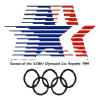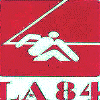


OTHER 1984 OLYMPIC YACHTING HIGHLIGHTS
[ Retrospective
] [ Venue ] [ Competition
] [ Results ] [ Highlights
] [ Conclusion ] [ Legacy
]



OTHER 1984 OLYMPIC
YACHTING HIGHLIGHTS
The Other Venue Stuff
What has yet to be mentioned in this rather brief "retrospective" are all the other elements that contributed to the success of the 1984 Olympic Regatta. They are noted here as follows:
Protocol
- Support Craft: 94 boats were used on the four course circles.
- Communications: over 200 licensed amateur radio operators took part in race management communications.
- Scoring: because of Protests, they often stayed until midnight to get the results out.
- Class Coordination: the vital link between competitors, team officials and the Organizing Committee.
- Harbor Master & staff: getting all the yachts and support craft berthed & launched on schedule every day!
- Games Staffing: responsible for signing-up and registering all the OCROC and other volunteers + delivering uniform vouchers.
- United States Coast Guard: The USCG had responsibility for water Venue Security, Port Safety & Security and Dignitary Security. The USCG committed over 500 personnel and 70 vessels to the Games to fulfill their mission.
- Meteorology: The National Weather Service provided weather & oceanographic forecasts and data in support of the Olympic Regatta .
- Yacht Delivery: Both before & after the Regatta required an enormous amount of effort and coordination.
- Venue Security: provided a safe environment for all involved at the venue. 74 people were involved, all paid or contract workers.
- Access Control & Athlete Registration: access to the venue and registration were very complicated problems, but were handled very well.
- Finance and Material Supply: enough said. It was tough especially the latter.
- Technology: installing & operating telephones, copiers, TVs, computers. word processors, non "Ham" radios. -enough said.
- Yacht & sail repair services: The former was housed in a 50' x 110' tent staffed by five volunteers and the later in a 10' x 40' trailer staffed by North Sails personnel.
- Food Services: provided on racing days over 1,700 box lunches per day.
- Transportation: competitors, officials etc., etc.
- Health Services: at the Sports Medicine Clinic at the Olympic Harbor provided for the medical needs of everyone at the venue. The Clinic was housed in a 12' x 56' trailer. The medical staff were all volunteers, who saw 1,002 patients over 24 days, nine of whom were sent to hospitals. The staff also had the responsibility for collecting urine samples for doping control.
- Language Services: provided over 14 different languages interpretation capabilities.
- Press Operations: handled 125 -140 journalists every day, both ashore and afloat.
- Community & Government Relations: from 1981-84 which provided for a successful interaction between the Organizing Committee and the community
The Protocol Committee was comprised of 24 volunteers, including the Director of Protocol and her Deputy. They were responsible for the following:
Ceremonies
- The Olympic Family lounge: was a 40' x 40' tent used on a daily basis by members of the IYRU delegation and key LAOOC Yachting staff.
- Jury Dinners: which were catered were served to members of the International Jury on each race day.
- Protocol Spectator Boats: one committee member served as a hostess on each of the seven large power yachts that were reserved for Olympic Family spectators.
- Venue Tours: average of three to four per day for 24 days. Click here to view Commissioner Hinshaw and his wife Nell lead IOC President Juan Antonio Samaranch on a tour of the Venue.
- IOC & NOC visitors to the venue: + heads of state or foreign government officials
- Travel Plans & Transportation: enough said.
- Social Events: including Team leaders reception (80 people), dinners honoring the Int'l. Measurement Committee (58 people) and the Int'l. Jury (114 people), Reception following the Opening Ceremony (168 people) and the Farewell Dinner (114 people).
- Spouses' Program: for the IYRU delegations' spouses, including many tours and shopping excursions.
Yachting Opening Ceremony
Was held at the Olympic Harbor the day following the Opening Ceremony at the L.A. Coliseum. A grandstand had been erected to accommodate 2,000+ spectators. The stands were occupied by the IYRU delegation, the Yachting staff and "team supporters".
The ceremony commenced with all sixty teams marching with LAOOC placard bearers and national flags in front of the grandstands accompanied by live band music. (Check it out)
While this was taking place, the 1932 gold medal winning eight-meter yacht "Angelita" sailed into the Olympic Harbor. After a few "Welcome" remarks by Commissioner Hinshaw, IYRU President Croce and Peter Tallberg, representing IOC President Samaranch, the LAOOC, IYRU and IOC flags were raised and the Yachting events of the Games were officially declared open.Awards and Closing Ceremony
Commenced at 1800 on the day following the last race at the same site described above. Following the march of the athletes, the awards ceremony began. After the medals were awarded, Commissioner Hinshaw and IYRU President Croce said their farewells and The Lord Killanin (representing IOC President Samaranch) officially closed the Olympic Regatta of the Games of the XXIIIrd Olympiad.
The LAOOC, IYRU and IOC flags were then lowered.Commissioner Hinshaw then invited the staff, athletes and team officials, members of the Olympic Family and all guests to a farewell party. It was held in the measurement and yacht repairs tents.
Over 3,000 attended and the last guests left at midnight.